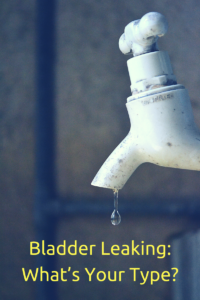Urinary incontinence (bladder leaks) can be a major problem for men and women. Over 25 million people suffer from urinary incontinence or bladder leaks. Those individuals are often embarrassed and isolate themselves from others. Did you know that it takes a woman an average of 7 years to report bladder symptoms to her provider (Phoenix Physical Therapy, 2017)? Don’t be a statistic. Instead, become empowered by learning about urinary incontinence and treatment options.
Two most common types of urinary incontinence:

Urge incontinence
- Have you ever felt you ‘gotta go, gotta go, gotta go right now’?
- Does your zipper on your pants ever get between you and the toilet?
- Are you someone who knows where every single bathroom is located within a 100-mile radius?
- Has it been too long to remember the last time you avoided the bathroom and got a decent night sleep?
If you answered yes to any of these, you likely suffer from urge incontinence, also known as overactive bladder (OAB).
Our bladder is a muscle, an involuntary muscle, which means it contracts (squeezes) without conscious control. In other words, our bladder has a mind of its own. When the bladder is full, the sacral nerves send a message to the brain that it needs to empty. When an individual has OAB, the sacral nerves send signals to the bladder at the wrong times, causing it to squeeze without warning and resulting in any or all of the following:
- Urinary Frequency – urinating 8 or more times per day or 2 or more times at night
- Urinary Urgency – the sudden, strong need to urinate immediately
- Urinary Urge Incontinence – leakage of urine that follows a sudden, strong urge to urinate (National Institute of Diabetes and Digestive and Kidney Disease, 2008).
Various treatment options exist for OAB. First line therapy recommendations include bladder retraining, dietary changes, and pelvic floor muscle exercises (National Guideline Clearinghouse, 2013).
The goal with bladder retraining is to increase the amount of time between emptying your bladder and the amount of fluid your bladder can hold. Dietary changes are the elimination of bladder irritants. The most common bladder irritants include coffee (regular and decaf), soda, alcohol, and highly spiced foods. Pelvic floor muscle exercises, also known as Kegels, are an essential part of suppressing the urge to urinate. The key to Kegel exercises is to perform them consistently and correctly. Did you know nearly 60% of women perform a Kegel exercise incorrectly (Kandadai, O’Dell, & Saini, 2015)? A sure way to master the Kegel is to imagine you are in an elevator with one other person and you have to pass gas… what muscle would you squeeze to prevent yourself from passing gas?
When conservative therapies do not relieve symptoms from OAB, medications are an option. Overactive bladder medications help relax the bladder muscle, so it does not squeeze as often. As a result, the medications may increase the bladder’s ability to store more urine. Medications may have unwanted side effects, so be sure to discuss those with your provider.
Despite consistent efforts with conservative treatment, some individuals require more help. Third line therapy for OAB includes neuromodulation and/or bladder Botox. Neuromodulation simply means nerve stimulation therapy. Nerve stimulation uses mild electrical pulses to stimulate the sacral nerve which controls the bladder. Bladder Botox involves injecting Botox into the bladder muscle. Botox is a paralytic; therefore, it reduces the number of times the bladder squeezes.
Stress Incontinence
- Do you leak urine when you laugh, cough, or sneeze?
- Have you stopped exercising for fear of embarrassing leaks?
- Have you avoided a trampoline like the plague due to bladder leaks?
If so, you may be experiencing stress incontinence. Stress incontinence is bladder leakage with exertion. In other words, you squirt when you exert. Stress incontinence occurs when the muscles and other tissues that support the bladder (pelvic floor muscles) and the muscles that regulate the release of urine (urinary sphincter) weaken. It’s a bit like using fingers to keep air escaping from a balloon. If the seal isn’t tight and strong, there will be leakage.
The International Journal of Urogynecology recently published an article indicating a 5-10% weight loss in overweight women can improve stress incontinence by 70%. For the average overweight woman, that equates to approximately 8lbs. What an encouraging statistic! It’s no wonder lifestyle modifications, including weight loss, are recommended as first-line therapy for stress incontinence (Swenson et al., 2017). In addition to weight loss, Kegels are essential to improving the strength of the pelvic floor. Remember, the key to Kegel exercises is to perform them consistently and correctly.
Additional conservative treatment options include bladder supports. Bladder supports are vaginal inserts that provide stabilization for the pelvic floor muscle. A pessary is a type of bladder support that can be used by women of all ages and come in various shapes and sizes. The Pelvic Guru recently published a blog that highly encouraged women who engage in CrossFit to wear a pessary for pelvic floor protection (Pelvic Guru, 2016). Another bladder support available over the counter is the Impressa. Impressa is a device inserted into the vagina, similar to a tampon.
When conservative therapies fail, surgery is an option. The gold standard surgical intervention for stress incontinence is the mid urethral sling utilizing vaginal mesh (American Urologic Association, 2013). While mid urethral slings have demonstrated to be a great solution for some women, they do come with some warning. Although the complication rates are low, vaginal mesh has been associated with post-op problems such as chronic pelvic pain and mesh exposure.
There is help
Urinary incontinence is not a disease, it is not a condition you have to live with, and it is not a normal part of aging. Urinary incontinence can significantly alter one’s quality of life and put us at risk for many problems including falls, depression, and fractures (Coyne et al, 2013). You are not alone with your problem. Seek out a healthcare professional who can help you sort through your symptoms and formulate a plan of care that works for you. Your bladder will thank you!
Sources:
American Urologic Association (2013). AUA Position Statement on the Use of Vaginal Mesh for the Surgical Treatment of Stress Urinary Incontinence (SUI). Retrieved October 31st,
Coyne, K., Wein, a., Nicholson, S., Kvasz, M., Chen, C., & Milson, I. (2013).
Comorbidities and personal burden of urgency urinary incontinence: A systematic review. International Journal of Clinical
Practice, 67(10), 1015-1033.
Kandadai, P., O’Dell, K., & Saini, J. (2015). Correct performance of pelvic muscle exercises in women reporting prior knowledge. Female Pelvic Medicine and Reconstructive Surgery, 21, 135-140.
National Guideline Clearinghouse (2013). Urinary incontinence: the management of urinary incontinence in women. Retrieved October 31st, 2017 from
National Institute of Diabetes and Digestive and Kidney Disease (2008). Bladder Control Problems & Nerve Disease. Retrieved October 31st, 2017 from
https://www.niddk.nih.gov/health-information/urologic-diseases/bladder-control-nerve-disease
Pelvic Guru (2016). 5 critical errors women make during crossfit. Retrieved October 31st, 2017 from
https://pelvicguru.com/2016/04/09/5-critical-errors-women-make-during-crossfit/
Phoenix Physical Therapy (2017). Urinary incontinence in women statistics. Retrieved November 1st, 2017 from http://phoenixpt.com/statistics/
Swenson, C., Kolenic, G., Trowbridge, E., Berger, M., Lewicky-Gaupp, C., Margulies, R., et al., (2017). Obesity and stress incontinence in women: compromised continence mechanism or excess bladder pressure during cough? International Urogynecology Journal, 28, 1377-1385.

